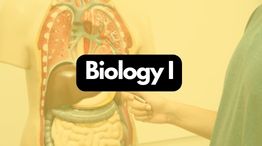
CATEGORY:
Science
Biology I
Course Access: Lifetime
Free
Course Overview
Biology, a full-year high school-level course, provides students with an introduction to the study of life. Students explore DNA, cells, organisms, and ecosystems. This course covers the requirements for life all over the globe and the interactions between living and non-living matter. Students will learn about the evolution of organisms and how genes are passed on through generations.
Course Include
- Scientific method and what goes into developing theories and hypotheses.
- Different characteristics of living things.
history and structure of DNA and how it replicates - The importance of carbon and the difference between monomers and polymers.
- various systems that make up an organism, such as the nervous, muscular, and immune systems
- The cycles of the environment such as, carbon, nitrogen and water.
- photosynthesis, light and dark reactions, and plant tissues
- energy flow, energy pyramids, and invasive species
- Biodiversity, resource partitioning, and ecosystem components.
- exploring atoms, compounds, and elements
- Pathogens and bacterial growth, finishing with microbiomes and food microbiology.
- The cell cycle, sexual, and asexual reproduction.
- The work of Mendel, alleles, and gene regulation
- Genetic disorders, genetic inheritance, mutations, and their environmental factors.
Evolution, starting with Charles Darwin, the evidence supporting evolution and survival of the fittest. - reproductive barriers, the different kinds of selection, and the bottleneck effect
- Binomial nomenclature, domains, and classifications
types of phylum, such as Mollusca, cnidarian, and nematode ending with Echinodermata and chordate.
